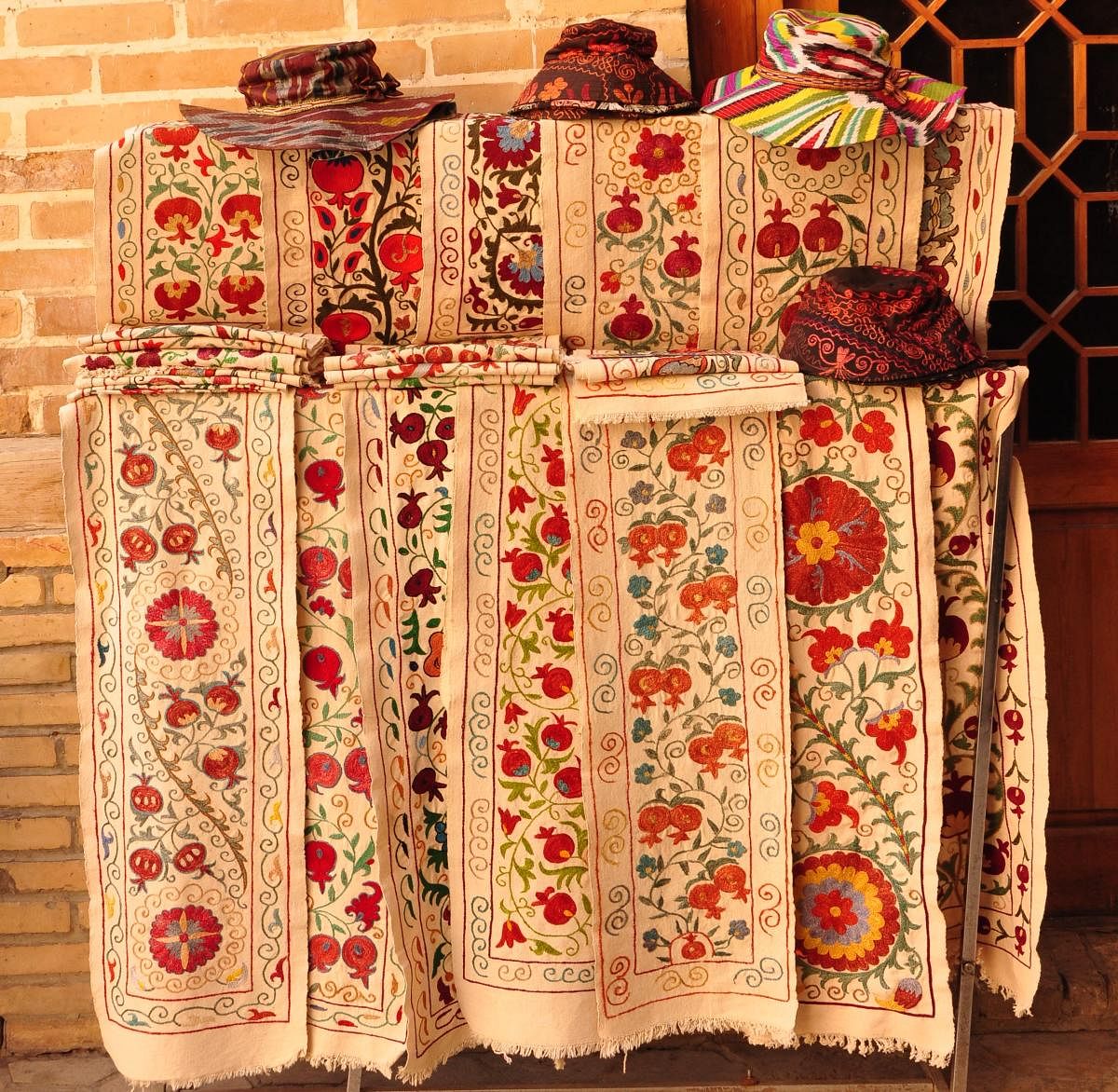
The Sitora-i-Mokhi Khossa, summer palace of Bukhara’s erstwhile emirs, is a sprawling complex of gardens and courtyards amidst which are residences, choikhona (tea room) and guest-houses displaying a stunning mix of architectural styles. Towards the end of
the palace grounds is the harem which now houses the Bukhara Museum of Decorative and Applied Arts where I see exceptional examples of suzani, Central Asia’s vibrant and intricate needlecraft.
According to custom, a suzani is prepared by a bride-to-be for her new home where it is initially used as a bedspread and then hung on the wall. Traditionally, handspun and handwoven cloth is the base upon which a medley of stitches are used to embroider patterns with dexterity.
Weaving and embroidering on cloth are amongst the oldest existing art forms of the world. Across civilisations, producing and embellishing textile was a prime activity and the prepared item a prized possession. Suzani is an illustration of a native textile that
almost always becomes an heirloom.
As I viewed suzanis at the museum, my initial impression was how conspicuously bold the patterns were. Indeed, from a distance they looked like applique work and some seemed as though they were a painting. On close inspection, I realised how minute stitches had been painstakingly embroidered to create these timeless pieces.
With looms being of a restricted width, the base fabric of a suzani is not a single piece of cloth but is always prepared by stitching together two or more panels. These panels are combined only after the embroidery has been done on each piece. And herein also lies
the skill of the needlework artistes as despite the pattern having been made on separate pieces, when joined, the suzani looks flawless. Suzani is a Persian term originating from the root word ‘suzan’, which means needle. This Central Asian embroidery is essentially a combination of satin, buttonhole and couching stitches. Usually the long satin stitch is used to fill in the motifs.
Unique braid
The strands are then tightly secured with small couching stitches that are done diagonally.The end result presents a striking three-dimensional effect which is what makes the suzani unique.
Some suzanis are also embroidered solely in crewel or chain stitch and look quite similar to the work done in Kashmir. However, it is the layout and patterns of the suzanis that make them distinctly stand apart.
The typical suzani motifs include stylised versions of astral symbols, particularly sun and moon; gul or flowers — predominantly roses, tulips, irises and carnations; fruits like almonds, cherries and pomegranates; and from the animal world it’s by and large the fish, parrot and tortoise — all considered symbols of good luck, that make it to the panels.
The suzani is usually bordered by vines. Some rare suzanis, perhaps made to order for nobles and royalty, steered clear of regular patterns and embroidered detailed court scenes. Having seen a wide range of suzanis during my trip to Uzbekistan, I noticed that the antique panels usually had solar symbols while the contemporary ones had floral motifs. My tour guide in Samarkand agreed with my perception and explained the reason for that. She said the earlier generations believed in the powers of nature and embroidering astral symbols meant they had blessings of the Creator.
As older views gave way to modern thinking, solar got replaced by decorative floral patterns; among them the pomegranate motif being the most popular, as it is considered a
symbol of fertility.
Warding off evil
Down the generations, what did not change, however, was embroidering nazar into a piece being prepared. That means a deliberate odd motif or a mistake by commission is made in the pattern to ward off nazar or the evil eye. This is a shared cultural belief across the region and needlework artistes in India too believe in it. It’s common to see the nazar on the phulkaris of Punjab and the applique panels of the Rabaris in Kutch. The stylisation of a suzani, in many ways, felt similar in idiom to Mughal art seen across India, the prime difference being in the patterns. While the suzani motifs are happily bold and colourful reflecting their nomadic origins, Mughal work, which got the
patronage of the royal courts, was known for being delicate. One became the hallmark of a people on the move, while the other was considered fit for kings. However, both are classics in their own accord.